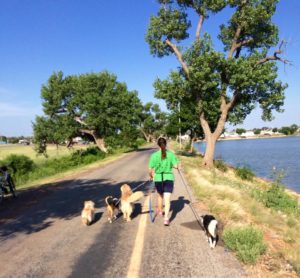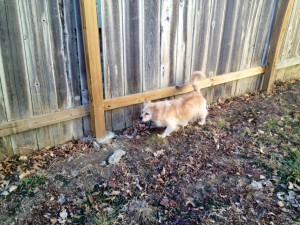Carmel Dog Zone formed in 2011. We offer dog training for all breeds and temperaments. We are committed to staying up-to-date on the most current scientific research available for dogs regarding both behavior and wellness. Our methods are effective, dog-friendly and family friendly.
What if I told you that your six week old puppy is at a serious disadvantage in life because he was taken too soon from his mother and littermates?
What if I told you the genetic factors were already in place with your dog’s aggression before she was even born?

Laura’s dogs that have taught her so much. From left to right: Chip, reactive rescue that used to attack vacuums and was food aggressive, Zoey, fearful of strangers, particularly men, had a “Caution” sign on her kennel door, Rocky, anxiety, and OCD behaviors eliminated with training, Emma, rarely handled–lived on a tie-out previously, bite history and was set to be euthanized. All happy and healthy family dogs!
What if I told you it wasn’t your fault your dog was attacked on a walk and now is reactive?
What if I told you your rescue dog was never abused or neglected, but improperly socialized and genetically fearful?
It is not your fault. Repeat it again. These things are out of your control. Genetics and environmental factors play such a role in behavior, we don’t even quite know how much (this is particularly true pertaining to genetics). So what can we do about it?
-Set realistic expectations for your dog. Everyone loves the dog that can go everywhere with ease. But does your dog actually enjoy it? Creating a relationship where you are aware of your dog’s state of mind is crucial. We have to be advocates for our dogs. Once you find things your dog truly enjoys, you’ve unlocked a whole new world of potential! And every dog is so different.
-Practice training homework with the goal of progress. Ending a session frustrated does not do any good for either of you. Instead, back track to something you know your dog is good at and try again next time.
-Reactivity never fully goes away. Ouch. I know. But it can be helped tremendously! (Ask us about whether your dog is reactive or not).
-“My rescue dog must have been abused because she’s terrified of men with beards.” Truth bomb time. It’s highly unlikely. Lack of socialization and temperament can and do create the perfect storm for fearful behavior to specific triggers.
The right training strategies can do wonders for your dog’s quality of life and your relationship together. Have questions for us? We welcome them! Oh, and it’s not your fault. 😉
Laura Neiheisel
There are so many flea control products available for dogs and I think I have tried them all. We live in a climate that has horrible flea infestations the majority of the year. I’ve tried the topical chemicals but did not like the effects on our dogs, my 15 year old Golden, especially. We also have cats, so some of the products are not safe to apply. When I was reading the labels, I was hesitant due to the warnings for their own personal health and ours.  “Caution: do not get product on your skin, wash immediately..” are some of the warnings. There had to be a better way! To the internet! 🙂
“Caution: do not get product on your skin, wash immediately..” are some of the warnings. There had to be a better way! To the internet! 🙂
I found Earth’s Answers Flea Powder and decided to give it a try. Vicki makes each batch with food grade ingredients. I’ve been applying this for several months now and it is mid-May; I have not seen any fleas on my dogs since! Remember to apply diligently and outside when you do. There has been no more seizure-like activity (Frontline caused this as did some of the other well-known brands) for my dogs and no more fleas! I don’t receive any perks or compensation to share this information with you all, but I did want to share it because of how well it is working. If you try it, let me know what you think.
Laura
“Have your puppy meet 100 new people in 100 days! If your puppy is already showing signs of timidity or fear, triple that to 300 exposures in 100 days.” Have you read that before, or been given that advice?
 Quality experiences matter more to your dog than the number, particularly if your dog is already showing fear. This is especially true with young animals. Tripling your puppy’s exposure to things that scare him or her is not going to eliminate the fear. Let’s picture your young child is terrified of heights, would making him face and focus heavily on that fear eliminate it? No, it could easily make him more fearful. Does that mean we should put our puppies in a bubble and not expose them to things? Absolutely not, but the logic is not there in making the experience happen more frequently when they are already shut down.
Quality experiences matter more to your dog than the number, particularly if your dog is already showing fear. This is especially true with young animals. Tripling your puppy’s exposure to things that scare him or her is not going to eliminate the fear. Let’s picture your young child is terrified of heights, would making him face and focus heavily on that fear eliminate it? No, it could easily make him more fearful. Does that mean we should put our puppies in a bubble and not expose them to things? Absolutely not, but the logic is not there in making the experience happen more frequently when they are already shut down.
All socialization and experiences should be intentional. Instead of having a check list in your mind with a number, think of the experience. This is how we can build our dog’s confidence, successful experiences that leave the dog thinking, “That was fun!” Socialization is so important, but owners with good intentions could easily get lost in the number. We want our puppies to feel good, built up and confident that we are leading them to positive experiences.
Have questions about this? Feel free to ask us!

I recently saw this quote directed towards parenting: “Don’t take too much credit nor too much blame for the way your children turn out” and thought how this, too, can be applied to dog owners.
Dogs are individuals. You may have heard or read that more than once, but I encourage you to really think about it for a minute. The faster we learn to accept this, the easier it is to help a dog be the best version of themselves. Can your dog learn to demonstrate behaviors we humans like? Absolutely! Will your strong, high-drive dog suddenly become a calm, couch potato? Probably not (and this is perfectly ok). Differences in breed traits, genetics, socialization and temperament all come into play to make your dog who he/she is. And these differences are beautiful things!
A personal case study: my dog, Zoey, was rescued at around 6 months of age. I found her trembling in a kennel at a local shelter with a cautionary sign above her door, “Extremely fearful..”. When we first began our adventure together, Zoey was terrified of men and most strangers. With training and positive experiences, her behavior has improved quite a bit over the years. However, Zoey will never be a dog that will be an extroverted, social butterfly. She’s sensitive and doesn’t tolerate improper handling or greetings. Because of her I have learned SO much. She’s made me a better dog owner and is one of the best dogs I’ll ever have.
A huge turning point for us is when I accepted who she is: a smart, sensitive individual. We cannot take full credit, or blame for who our dogs are. This is extremely freeing when we work on training and our relationship(s) and I hope it provides encouragement to you as well!
 You go to let your dogs outside and after a few seconds, you hear barking. Fence fighting starts by the dogs on either side being frustrated with their inability to properly sniff one another. This frustration causes the dogs to pace and lunge at the fence line. Sometimes, this builds up to further frustration that eventually leads to what we call fence fighting. This behavior can cause a redirection to another canine member of the family, or worse, the owner (usually when the owner tries to grab their dog).
You go to let your dogs outside and after a few seconds, you hear barking. Fence fighting starts by the dogs on either side being frustrated with their inability to properly sniff one another. This frustration causes the dogs to pace and lunge at the fence line. Sometimes, this builds up to further frustration that eventually leads to what we call fence fighting. This behavior can cause a redirection to another canine member of the family, or worse, the owner (usually when the owner tries to grab their dog).
So, what can we do to prevent this from happening each time we let our dogs out? First, begin with a long leash and a handful of treats while the neighbor dog is not outside. Start out by practicing with each individual dog in the family if you have multiple dogs. Each time your dog begins to show interest on the fence line, tell your dog to “leave it” and come to you. For many dogs, it has become a habit to run over to the fence line the moment they are let outside. If you need help forming a strong foundational “leave it” and “come” we can help.
After your dog is listening well with a low level of distractions, go outside again with a long leash while the neighbor dog is outside. Reward each time your dog is not paying attention to the other dog. The moment your dog begins to fixate on the fence line again, ask your dog to “leave it” and reward if the dog does. If your dog cannot listen at this level, you need to calmly remove your dog from the environment and start again with less distractions.
Eventually the goal is to have your dog able to listen off leash. Below is a video of my dog, Chip:
Chip is the most reactive out of my dogs, but has learned to control himself. Notice how each time he looks at me instead of the barking dog next door, he gets a reward. This has also calmed our neighbor dog down, which used to try and bite my dogs through the fence holes.
I hope this post is a helpful foundation for you to stop fence fighting. Please contact us if you have any questions!
Post By: Laura Neiheisel
